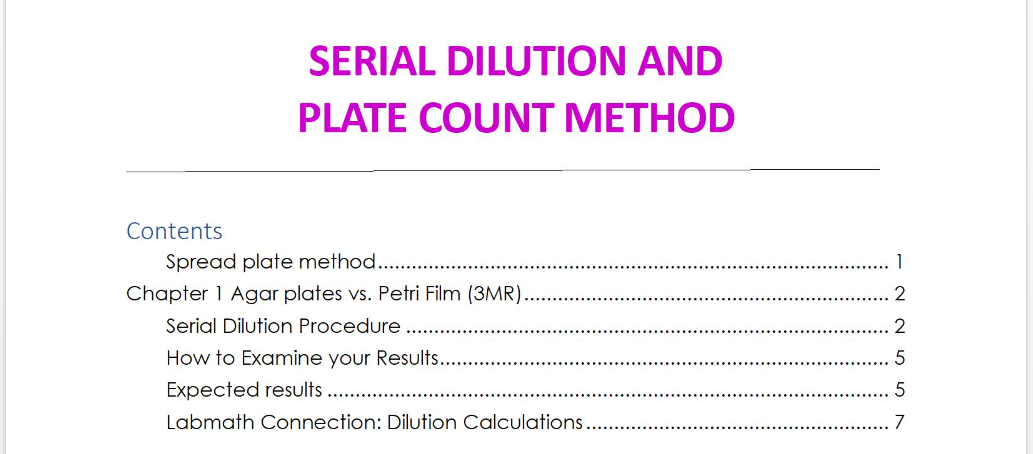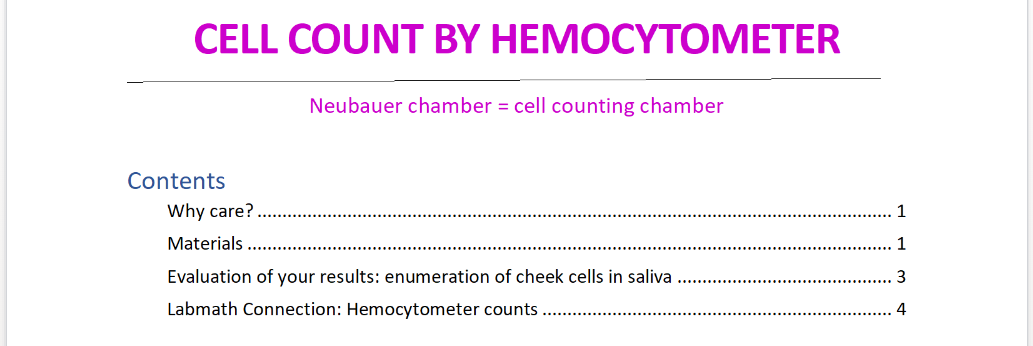Modules – Skills & Tools
Enumeration of Microbes
Background Information
WHY YOU SHOULD CARE ABOUT: Enumerating Microbes
Understanding and executing methods and techniques microbes are counted is one of the most essential tools in any microbiology and molecular biology laboratory. Knowing the difference between life cell count and densitometric count, where we don’t know if cells are life and also knowing the difference between indirect and indirect cell count is important. Different laboratory instruments are used for different methods. This section also contains essential lab math calculations to understand dilutions and growth curves are part of the enumeration process.
Access OpenStax: 9.1 How Microbes Grow
Learning Objectives:
After completing this module, students will be able to:
- Recall new vocabulary and definitions that pertain to this module.
- Estimate the number of microorganisms in a sample (direct count – hemocytometer, viable plate count – serial dilution, and spectrophotometric methods – growth curve).
- Demonstrate an ability to formulate hypotheses and design experiments based on the scientific method (growth curve).
- Analyze and interpret results from a variety of microbiological methods.
- Use mathematical reasoning and graphing skills to solve problems in microbiology.
- Design experiments on how viable plate counts are performed, growth curve experiments are conducted, and how a hemocytometer is used.
- Learn how to do a serial dilution sand determine the number of bacteria in your saliva (CFU/ml)
History Connection
Case Study
The Blue Bell listeriosis outbreak of 2010-2015 and recall of 2015
/https://static.texastribune.org/media/images/2015/04/23/bluebell-listeria-outbreak-infographicTT.jpg)
Imagine you are working a Merieux Nutriscience, a food testing company in Gainesville, Florida. Your job is to test samples for potential pathogens. One day you get several tubs of Blue Bell ice cream to analyze. Following proper SOPs (standard operating procedures), using the correct media and tests, you determine that the ice cream contains Listeria monocytogenes. Describe your process for enumeration of the pathogen. what other methods for detecting listeria are used? Here is some information how Merieux is testing for Listeria.
Virtual Lab Simulation
Pathogen Modeling Program (PMP) Online
Pathogen Modeling Program (PMP) Online
To compare the rate of growth between different cultures the steepest part of the growth curve (= logarithmic growth phase) is used to determine GT GT=((t2-t1)*log(2))/(log(OD2)-log(OD1)) or GT=((t2-t1)*log(2))/(log(CFU/ml2)-log(CFU/ml1)) depending on the method used for the enumeration.
Go to the PMP website and explore the different options, how to change parameters and how to copy and export the raw data. Then ask a question, a scientific question you can answer with the data and parameter given. For example, you can compare growth rate of two pathogens under the same conditions, or compare the growth rate of a pathogen under different conditions. Make sure you change one variable at a time.
Once you have your experimental design, copy the corresponding data into Excel or Google sheets and graph your results. Calculate the growth rate from the raw data and compare to the number given on the PMP site. Add the experiment and data analysis to your ELN and discuss the results.
Just while talking about food born pathogens, check out how many food born Salmonella cases there are in the USA each year, guess first…….it’s a pretty sunning number.
Online Lab
Activity: Saliva Enumeration using serial dilution on Petrifilm plates
Lab Kit Materials for this Activity:
- Microcentrifuge tubes 1.5mL (x10)
- Aerobic Count (AC) Petrifilms (x10)
- Petrifilm Spreader
- 10mL PBS
Video Tutorials
Plating 10 Fold Serial Dilution on Petrifilm
Procedure
Make a 10 fold serial dilution with your saliva
- Initial and date the Petrifilm and label with the following dilutions (Make sure to label in the corner of the film so that it doesn’t interfere with counting): 10-4, 10-5, 10-6, 10-7, and 10-8 and control indicating the dilutions you will put onto each Petrifilm
- Label 10 Eppendorf tubes with the following label/dilutions: 10-1, 10-2, 10-3, 10-4, 10-5, 10-6, 10-7, 10-8 and “control”
- Fill all your Eppendorf tubes with 1080 μl diluent using an Eppendorf pipette (you can pipette 2 x 540 μl as you CANNOT pipette 1080 μl with your P1000)
- Take a new Eppendorf tube and label it “saliva”. Collect some of your spit (saliva) in a that Eppendorf tube ~ 200μl – this is your undiluted sample stock. You want to find out the CFU/ml in that sample
- Make a 1:10 dilution series: Mix saliva by shaking the tube and aseptically transfer 120 μl of the saliva to your tube labeled 10-1. This is a 1/10 or 10-1 dilution.
- Close the tube and vortex the tube containing the 10-1 dilution
- Aseptically transfer 120 μl of the 10-1 dilution to the next tube, labeled 10-2. This is a 1/100 or 10-2 dilution. Mix.
- Using the same pipette tip, repeat this process until you complete the dilution series. (1 to 2, 2 to 3, 3 to 4, 4 to 5, etc.)
- Do not add any saliva to the tube labeled “control”. Fill 1080 μl of your sterile diluent (PBS) into the tube called “control”.
- Add 1 ml of sterile PBS from your “control” Eppendorf tube to your “control” Petrifilm
Plating on Petrifilm
- After the last tube has been diluted, start with the 10-8 dilution tube, mix, open
- Place the 3M Petrifilm AC Plate on a flat, level surface
- Lift the top film and with the pipette perpendicular dispense 1 mL of sample suspension onto the center of bottom film
- Drop the top film down onto the sample to prevent trapping air bubbles, tapping gently with your fingers to spread the sample out
- Continue the same process with the Petrifilm labeled 10-7 . Gently spread out the liquid after you close the Petrifilm.
- Then inoculate the remaining Petrifilms, moving from highest dilution to lower dilution, transferring 1 mL the 10-6, 10-5 10-4 dilution tubes. You can use the same tip for the procedure.
- Make sure you inoculate one Petrifilm “control” with your diluent only.
- Stack the Petrifilms, and leave them for 48 hours at room temperature. The colonies will appear as red dots.
ELN Reflection
Add pictures of your petrifilms to your ELN. Calculate saliva CFU/mL based on petrifilm growth (include calculations).
In-Person Lab
Enumeration – Serial Dilution:
Resources
Take a look at the appropriate module for the vocabulary that is being tested: Microbiology @ UF Lab Terminology Quizlet.
Overview of enumeration (Dr. Oli)
Demonstration of the serial dilution by Dr. Oli
Dr. Oli teaching Dariel (Minute: 29:23)
Here’s a good video that helped me for the serial dilutions. It gives an overview that is easily understood. https://www.youtube.com/watch?v=yYWFX4IXc5Y. The video on teaching Dariel is great, but I cannot get a visual image of how to do serial dilution step-by-step




